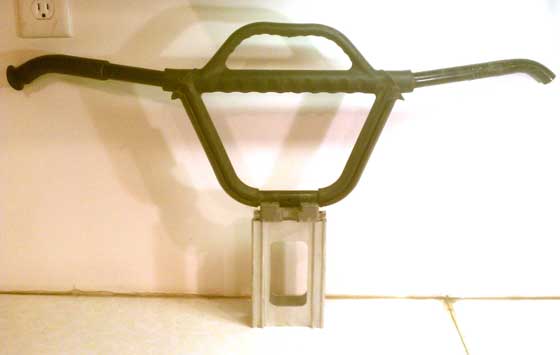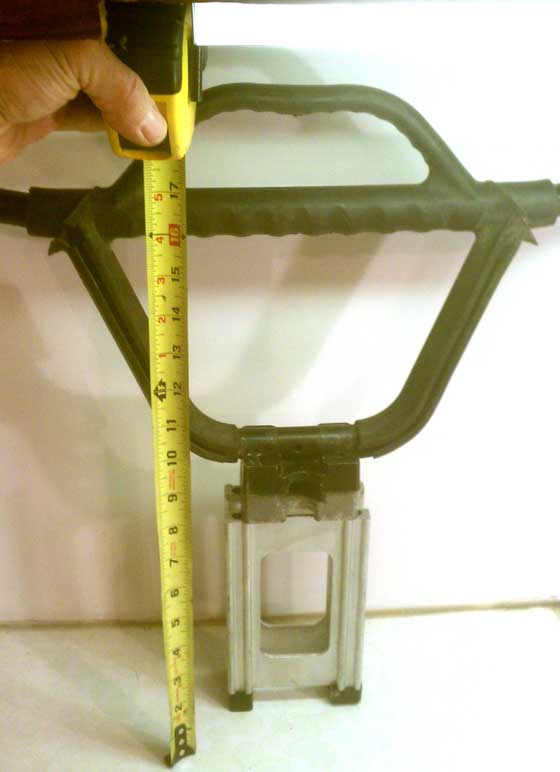
When building his 1978 Arctic Cat El Tigre for the upcoming vintage racing season, Shane Gerwing appeared to have several options for his handlebar set-up.
But as we all know, when it comes to handlebars, there really is just one choice: Taller!

As with any good snowmobile set-up, the greater the distance between the grips and the running boards, the better. Fortunately, Shane had options, including a tall bar and several risers.
This first attempt (above) was good, but why stop at stacking just two risers when you have three?!?

And with the third block cobbled into place, the tape measure confirms that Shane’s achieved the critical high-teens for inches of height.
In fact, with the added mountain portion of the bar, he’s pushing the magical 10-plus-10-equals-20-in. handlebar riser territory (or, in this case, the 8-plus-1.5-plus-1.5-plus-7-in.).
This is where the pros are, and where the wannabe’s aim. This is where we all might eventually find ourselves.
Good luck this season, Shane, and don’t worry about shoulder fatigue or numb fingers. Those are the consequences of being cool.
And keep us posted on your ’78 Tiger build!




I wish the race sleds still came with the bars with the full hook at the top. Best handlebars ever!
Lol,, had me thinking (with opening line phrased as is) that it was gonna’ be a 10″ + 10″ type of article, LMAO
Shane, it looks like you’ve done some serious shopping at the Outlaw and Haydays swaps. I can’t wait to see the finished Tigger. Keep us updated on the progress! Bob
I got some NOS Energy Drink, ERX motorpark, and Speedwerx decals to put on as well-adds 5mph top end! Can’t wait for the first 1.5” snowfall to go ditchbangin, freestylin’ & tailstandin’. Ill keep you all posted on the progress.
Oh I forgot the most important DECAL, the Arctic Insider Decal!!!!
Thanks again John for the great site!
Whatever bars you use, either don’t use the original post, or re-do the welds on the original – they broke with just the leverage from the stock short bars.
Its not the only way, but IMO its the easiest way. There are USB -> Serial aapetdrs that would work with your machines that cost a few dollars. Since this post was written, pfsense has started to release builds of the embedded kernel with vga enabled. This would allow you to avoid using the serial connection altogether. However, since these aren’t .iso files that can be burned to a CD, you would still need a way to copy to image file to the internal DOM. This is why I recommend the method in this POST as booting into a Linux Live CD and copying files would be more difficult for most users.
No. Just the embedded NIC and a silgne PCI slot. You would have to buy a dual NIC to put into the slot. These can be had for $15 on ebay. Just make sure not to accidentally get a PCI-E adapter which is much more prominent these days.
No. Just the embedded NIC and a silgne PCI slot. You would have to buy a dual NIC to put into the slot. These can be had for $15 on ebay. Just make sure not to accidentally get a PCI-E adapter which is much more prominent these days.
No. Just the embedded NIC and a silgne PCI slot. You would have to buy a dual NIC to put into the slot. These can be had for $15 on ebay. Just make sure not to accidentally get a PCI-E adapter which is much more prominent these days.
The really nice mareird PE teacher who doesn’t speak any English is the only one in my office, yet. The boys are running up and down the hall doing Gilbert Grape screams and wearing their street clothes. People have spoken lots of Korean to me already this morning and I’ve understood it all. And I’m getting kimbap. Not too bad a start, I guess. Plus the doors/windows are closed…. http://wkqpggw.com [url=http://xanklxv.com]xanklxv[/url] [link=http://tblliiho.com]tblliiho[/link]
The really nice mareird PE teacher who doesn’t speak any English is the only one in my office, yet. The boys are running up and down the hall doing Gilbert Grape screams and wearing their street clothes. People have spoken lots of Korean to me already this morning and I’ve understood it all. And I’m getting kimbap. Not too bad a start, I guess. Plus the doors/windows are closed…. http://wkqpggw.com [url=http://xanklxv.com]xanklxv[/url] [link=http://tblliiho.com]tblliiho[/link]
The really nice mareird PE teacher who doesn’t speak any English is the only one in my office, yet. The boys are running up and down the hall doing Gilbert Grape screams and wearing their street clothes. People have spoken lots of Korean to me already this morning and I’ve understood it all. And I’m getting kimbap. Not too bad a start, I guess. Plus the doors/windows are closed…. http://wkqpggw.com [url=http://xanklxv.com]xanklxv[/url] [link=http://tblliiho.com]tblliiho[/link]
It has long been rumored that mcutfaanurers of items such as razors and batteries specifically produce their products an inferior level in order to ensure repeat business. A similar paradox is occurring in the information security space where many are complaining that the PCI Data Security Standard (PCI DSS) is too complex and costly. What is most troubling is that such opinions are being written in periodicals and by people that should know better. PCI came to life when Visa, MasterCard, American Express, Diner’s Club, Discover, and JCB collaborated to create a new set of standards to deal with credit card fraud. PCI requires that all merchants and service providers that handle, transmit, store or process information concerning any of these cards, or related card data, be required to be compliant with the PCI DSS. If they are not compliant, they can face monetary penalties and/or have their card processing privileges terminated by the credit card issuers. The primary purpose of PCI is to force organizations to embrace common security controls to protect credit card data and reduce fraud and theft. The following are the six primary control areas and 12 specific requirements of the PCI DSS: Build and maintain a secure network 1. Install and maintain firewall configurations 2. Do not use vendor-supplied or default passwords Protect cardholder data 3. Protect stored data 4. Encrypt transmissions of cardholder data across public networks Maintain a vulnerability management program 5. Use and regularly update anti-virus software 6. Develop and maintain secure systems and applications Implement Strong Access Control Measures 7. Restrict access to need-to-know 8. Assign unique IDs to each person with computer access 9. Restrict physical access to cardholder data Regularly monitor and test networks 10. Monitor and track all access to network resources and cardholder data 11. Regularly test security systems and processes Maintain an information security policy 12. Maintain a policy that addresses information security A quick review of these 12 items shows that PCI is a textbook example of the fundamentals of information security. With that, PCI Compliance: Understand and Implement Effective PCI Data Security Standard Compliance is an excellent resource that provides the reader with all of the fundamental information needed to understand and implement PCI DSS. The books 13 chapters provide the reader with a comprehensive overview of all of the details and requirements of PCI. The first three chapters provide an overview of the basics about PCI and the basic requirements of the standard. The following six chapters go into detail about each of the primary control areas. In particular, chapter 6 provides a good overview of the PCI logging requirements. This requirement can be time-consuming to put into place. The author notes that a commonly overlooked but essential requirement, namely that of accurate and synchronized time on network devices. Enterprise information network and security infrastructure devices are highly dependent on synchronized time and PCI recognizes that correct time is critical for transactions across a network. In a further discussion about synchronized time in chapter 9, the author unfortunately makes an error when he states that local hardware is considered a stratum 1 time source since it gets its time from its own CMOS. From an NTP perspective, only a device that is directly linked to a stratum-0 device is called a stratum-1. CMOS clocks are notoriously inaccurate and can’t be relied upon. The title of chapter 12 is both amusing and accurate `Planning to fail your first Audit’. The irony is that so many organizations lack a CISO or formal business security program in place designed to protect corporate information assets. They don’t focus on information security as a process, rather as a set of products or regulatory items to be checked-off. Yet, these same organizations are surprised when they fail an audit. The book concludes in chapter 13 with the well-known observation that security is a process, not an event. The book astutely notes that it is impossible to be PCI compliant without approaching security as a process. Trying to achieve compliance without integrating the various aspects in an integrated fashion is bound to fail. Overall, PCI Compliance: Understand and Implement Effective PCI Data Security Standard Compliance is a great book for one of the most sensible security standards ever. Anyone who has PCI responsibilities or wants to gain a quick understanding of the PCI DSS requirements will find the book to be quite valuable. http://stoqqlezeg.com [url=http://uktfmcr.com]uktfmcr[/url] [link=http://oinoikdlky.com]oinoikdlky[/link]
It has long been rumored that mcutfaanurers of items such as razors and batteries specifically produce their products an inferior level in order to ensure repeat business. A similar paradox is occurring in the information security space where many are complaining that the PCI Data Security Standard (PCI DSS) is too complex and costly. What is most troubling is that such opinions are being written in periodicals and by people that should know better. PCI came to life when Visa, MasterCard, American Express, Diner’s Club, Discover, and JCB collaborated to create a new set of standards to deal with credit card fraud. PCI requires that all merchants and service providers that handle, transmit, store or process information concerning any of these cards, or related card data, be required to be compliant with the PCI DSS. If they are not compliant, they can face monetary penalties and/or have their card processing privileges terminated by the credit card issuers. The primary purpose of PCI is to force organizations to embrace common security controls to protect credit card data and reduce fraud and theft. The following are the six primary control areas and 12 specific requirements of the PCI DSS: Build and maintain a secure network 1. Install and maintain firewall configurations 2. Do not use vendor-supplied or default passwords Protect cardholder data 3. Protect stored data 4. Encrypt transmissions of cardholder data across public networks Maintain a vulnerability management program 5. Use and regularly update anti-virus software 6. Develop and maintain secure systems and applications Implement Strong Access Control Measures 7. Restrict access to need-to-know 8. Assign unique IDs to each person with computer access 9. Restrict physical access to cardholder data Regularly monitor and test networks 10. Monitor and track all access to network resources and cardholder data 11. Regularly test security systems and processes Maintain an information security policy 12. Maintain a policy that addresses information security A quick review of these 12 items shows that PCI is a textbook example of the fundamentals of information security. With that, PCI Compliance: Understand and Implement Effective PCI Data Security Standard Compliance is an excellent resource that provides the reader with all of the fundamental information needed to understand and implement PCI DSS. The books 13 chapters provide the reader with a comprehensive overview of all of the details and requirements of PCI. The first three chapters provide an overview of the basics about PCI and the basic requirements of the standard. The following six chapters go into detail about each of the primary control areas. In particular, chapter 6 provides a good overview of the PCI logging requirements. This requirement can be time-consuming to put into place. The author notes that a commonly overlooked but essential requirement, namely that of accurate and synchronized time on network devices. Enterprise information network and security infrastructure devices are highly dependent on synchronized time and PCI recognizes that correct time is critical for transactions across a network. In a further discussion about synchronized time in chapter 9, the author unfortunately makes an error when he states that local hardware is considered a stratum 1 time source since it gets its time from its own CMOS. From an NTP perspective, only a device that is directly linked to a stratum-0 device is called a stratum-1. CMOS clocks are notoriously inaccurate and can’t be relied upon. The title of chapter 12 is both amusing and accurate `Planning to fail your first Audit’. The irony is that so many organizations lack a CISO or formal business security program in place designed to protect corporate information assets. They don’t focus on information security as a process, rather as a set of products or regulatory items to be checked-off. Yet, these same organizations are surprised when they fail an audit. The book concludes in chapter 13 with the well-known observation that security is a process, not an event. The book astutely notes that it is impossible to be PCI compliant without approaching security as a process. Trying to achieve compliance without integrating the various aspects in an integrated fashion is bound to fail. Overall, PCI Compliance: Understand and Implement Effective PCI Data Security Standard Compliance is a great book for one of the most sensible security standards ever. Anyone who has PCI responsibilities or wants to gain a quick understanding of the PCI DSS requirements will find the book to be quite valuable. http://stoqqlezeg.com [url=http://uktfmcr.com]uktfmcr[/url] [link=http://oinoikdlky.com]oinoikdlky[/link]
It has long been rumored that mcutfaanurers of items such as razors and batteries specifically produce their products an inferior level in order to ensure repeat business. A similar paradox is occurring in the information security space where many are complaining that the PCI Data Security Standard (PCI DSS) is too complex and costly. What is most troubling is that such opinions are being written in periodicals and by people that should know better. PCI came to life when Visa, MasterCard, American Express, Diner’s Club, Discover, and JCB collaborated to create a new set of standards to deal with credit card fraud. PCI requires that all merchants and service providers that handle, transmit, store or process information concerning any of these cards, or related card data, be required to be compliant with the PCI DSS. If they are not compliant, they can face monetary penalties and/or have their card processing privileges terminated by the credit card issuers. The primary purpose of PCI is to force organizations to embrace common security controls to protect credit card data and reduce fraud and theft. The following are the six primary control areas and 12 specific requirements of the PCI DSS: Build and maintain a secure network 1. Install and maintain firewall configurations 2. Do not use vendor-supplied or default passwords Protect cardholder data 3. Protect stored data 4. Encrypt transmissions of cardholder data across public networks Maintain a vulnerability management program 5. Use and regularly update anti-virus software 6. Develop and maintain secure systems and applications Implement Strong Access Control Measures 7. Restrict access to need-to-know 8. Assign unique IDs to each person with computer access 9. Restrict physical access to cardholder data Regularly monitor and test networks 10. Monitor and track all access to network resources and cardholder data 11. Regularly test security systems and processes Maintain an information security policy 12. Maintain a policy that addresses information security A quick review of these 12 items shows that PCI is a textbook example of the fundamentals of information security. With that, PCI Compliance: Understand and Implement Effective PCI Data Security Standard Compliance is an excellent resource that provides the reader with all of the fundamental information needed to understand and implement PCI DSS. The books 13 chapters provide the reader with a comprehensive overview of all of the details and requirements of PCI. The first three chapters provide an overview of the basics about PCI and the basic requirements of the standard. The following six chapters go into detail about each of the primary control areas. In particular, chapter 6 provides a good overview of the PCI logging requirements. This requirement can be time-consuming to put into place. The author notes that a commonly overlooked but essential requirement, namely that of accurate and synchronized time on network devices. Enterprise information network and security infrastructure devices are highly dependent on synchronized time and PCI recognizes that correct time is critical for transactions across a network. In a further discussion about synchronized time in chapter 9, the author unfortunately makes an error when he states that local hardware is considered a stratum 1 time source since it gets its time from its own CMOS. From an NTP perspective, only a device that is directly linked to a stratum-0 device is called a stratum-1. CMOS clocks are notoriously inaccurate and can’t be relied upon. The title of chapter 12 is both amusing and accurate `Planning to fail your first Audit’. The irony is that so many organizations lack a CISO or formal business security program in place designed to protect corporate information assets. They don’t focus on information security as a process, rather as a set of products or regulatory items to be checked-off. Yet, these same organizations are surprised when they fail an audit. The book concludes in chapter 13 with the well-known observation that security is a process, not an event. The book astutely notes that it is impossible to be PCI compliant without approaching security as a process. Trying to achieve compliance without integrating the various aspects in an integrated fashion is bound to fail. Overall, PCI Compliance: Understand and Implement Effective PCI Data Security Standard Compliance is a great book for one of the most sensible security standards ever. Anyone who has PCI responsibilities or wants to gain a quick understanding of the PCI DSS requirements will find the book to be quite valuable. http://stoqqlezeg.com [url=http://uktfmcr.com]uktfmcr[/url] [link=http://oinoikdlky.com]oinoikdlky[/link]